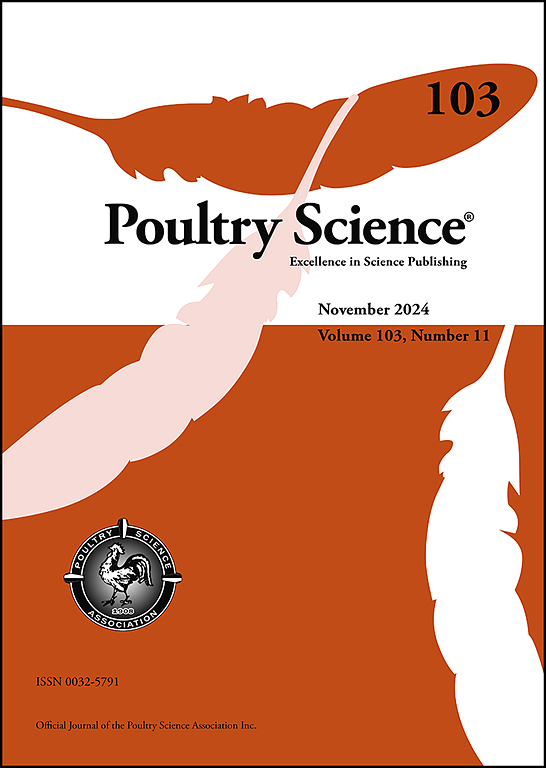百里香、肉桂和石榴油在热应激肉鸡中的抗氧化特性
IF 3.8
1区 农林科学
Q1 AGRICULTURE, DAIRY & ANIMAL SCIENCE
引用次数: 0
摘要
本试验旨在评价不同饲料添加剂对肉鸡生长性能和热应激缓解的影响。选取300只1日龄科布肉仔鸡,随机分为5个处理,每个处理6个重复(10只/重复)。处理1(对照)在1 ~ 42日龄期间在热中性条件下饲喂基础饲粮(BD)。处理2(+对照)也在热中性条件下从第1天至28岁饲喂BD,然后暴露于循环热应激(HS;在第五周内,每天早上9点到下午5点之间的温度为36°C,然后在下午7点到晚上9点之间的温度为24°C。第5周,第1 ~ 42天,处理3、处理4和处理5采用相同的HS方案,分别饲喂含有15g/kg百里香油(TO)、肉桂油(CO)和石榴油(PO)的相同BD。与热中性对照组相比,HS对照组表现出较低的ADFI、较高的FCR、较高的死亡率、血浆生化物质的改变和抗氧化能力的降低。恢复期肉仔鸡最终体重提高14.4%,平均日增重提高25.8%。与HS对照组的10%相比,FCR提高了16.9%,死亡率下降到6%,表明热应激下的损失减少。与HS对照组相比,TO和CO处理也显示出有益的效果。与对照组相比,添加饲料添加剂降低了血浆胆固醇、甘油三酯和丙二醛含量,提高了血浆谷胱甘肽过氧化物酶活性和总抗氧化能力。与HS对照相比,TO、CO和PO处理表现出更高的血浆超氧化物歧化酶活性。与HS对照相比,所有补充处理的H/L比均较低(P <;0.05)。与对照组相比,PO和TO处理增加了空肠绒毛/隐窝比率。综上所述,在肉鸡饲粮中添加PO、TO和CO可以缓解热应激效应,提高生长性能,并有可能提高家禽养殖户的盈利能力,其中PO在热中性和热应激条件下都能提供最显著的效益。本文章由计算机程序翻译,如有差异,请以英文原文为准。
The antioxidative properties of thyme, cinnamon, and pomegranate oils in heat-stressed broilers
This study evaluated the effects of different feed additives on growth performance and heat stress mitigation in broiler chickens. Three hundred 1-d-old Cobb broiler chicks were randomly allocated into five treatments, each treatment contained six replicates (10 birds/replicate). Treatment 1 (-Control) was fed a basal diet (BD) under thermo-neutral conditions between d 1 and 42 of age. Treatment 2 (+Control) also fed the BD under thermo-neutral conditions from d 1 to 28 of age, followed by exposure to cyclic heat stress (HS; 36°C between 0900 and 1700 h, then to 24°C between 1700 and 0900 h daily) during the fifth week. During the fifth week, Treatments 3, 4, and 5 underwent the same HS regime and fed the same BD containing 15g/kg of thyme oil (TO), cinnamon oil (CO), and pomegranate oil (PO) from d 1 to 42, respectively. Compared to the thermoneutral control, HS control exhibited lower ADFI, higher FCR, increased mortality rate, altered plasma biochemicals, and reduced anti-oxidant capacity. Broilers supplemented with PO showed a 14.4 % increase in final BW and a 25.8 % in ADG during recovery period. FCR was improved by 16.9 %, and mortality dropped to 6 % compared to 10 % in the HS control, suggesting reduced losses under heat stress. TO and CO treatments also showed beneficial effects compared to the HS control group. The supplemented feed additives decreased plasma cholesterol, triglycerides, and malondialdehyde content, while increasing plasma glutathione peroxidase activity and total antioxidant capacity relative to the HS control. TO, CO, and PO treatments exhibited higher plasma superoxide dismutase activity compared to the HS control. All supplemented treatments showed lower H/L ratio compared to HS control (P < 0.05). The PO and TO treatments exhibited an increased jejunal villus/crypt ratio relative to the control groups. In conclusion, supplementing broiler diets with PO, TO, and CO can alleviate heat stress effects, improve growth performance, and potentially boost profitability for poultry farmers, with PO providing the most significant benefits in both thermoneutral and heat stress conditions.
求助全文
通过发布文献求助,成功后即可免费获取论文全文。
去求助
来源期刊

Poultry Science
农林科学-奶制品与动物科学
CiteScore
7.60
自引率
15.90%
发文量
0
审稿时长
94 days
期刊介绍:
First self-published in 1921, Poultry Science is an internationally renowned monthly journal, known as the authoritative source for a broad range of poultry information and high-caliber research. The journal plays a pivotal role in the dissemination of preeminent poultry-related knowledge across all disciplines. As of January 2020, Poultry Science will become an Open Access journal with no subscription charges, meaning authors who publish here can make their research immediately, permanently, and freely accessible worldwide while retaining copyright to their work. Papers submitted for publication after October 1, 2019 will be published as Open Access papers.
An international journal, Poultry Science publishes original papers, research notes, symposium papers, and reviews of basic science as applied to poultry. This authoritative source of poultry information is consistently ranked by ISI Impact Factor as one of the top 10 agriculture, dairy and animal science journals to deliver high-caliber research. Currently it is the highest-ranked (by Impact Factor and Eigenfactor) journal dedicated to publishing poultry research. Subject areas include breeding, genetics, education, production, management, environment, health, behavior, welfare, immunology, molecular biology, metabolism, nutrition, physiology, reproduction, processing, and products.
 求助内容:
求助内容: 应助结果提醒方式:
应助结果提醒方式:


